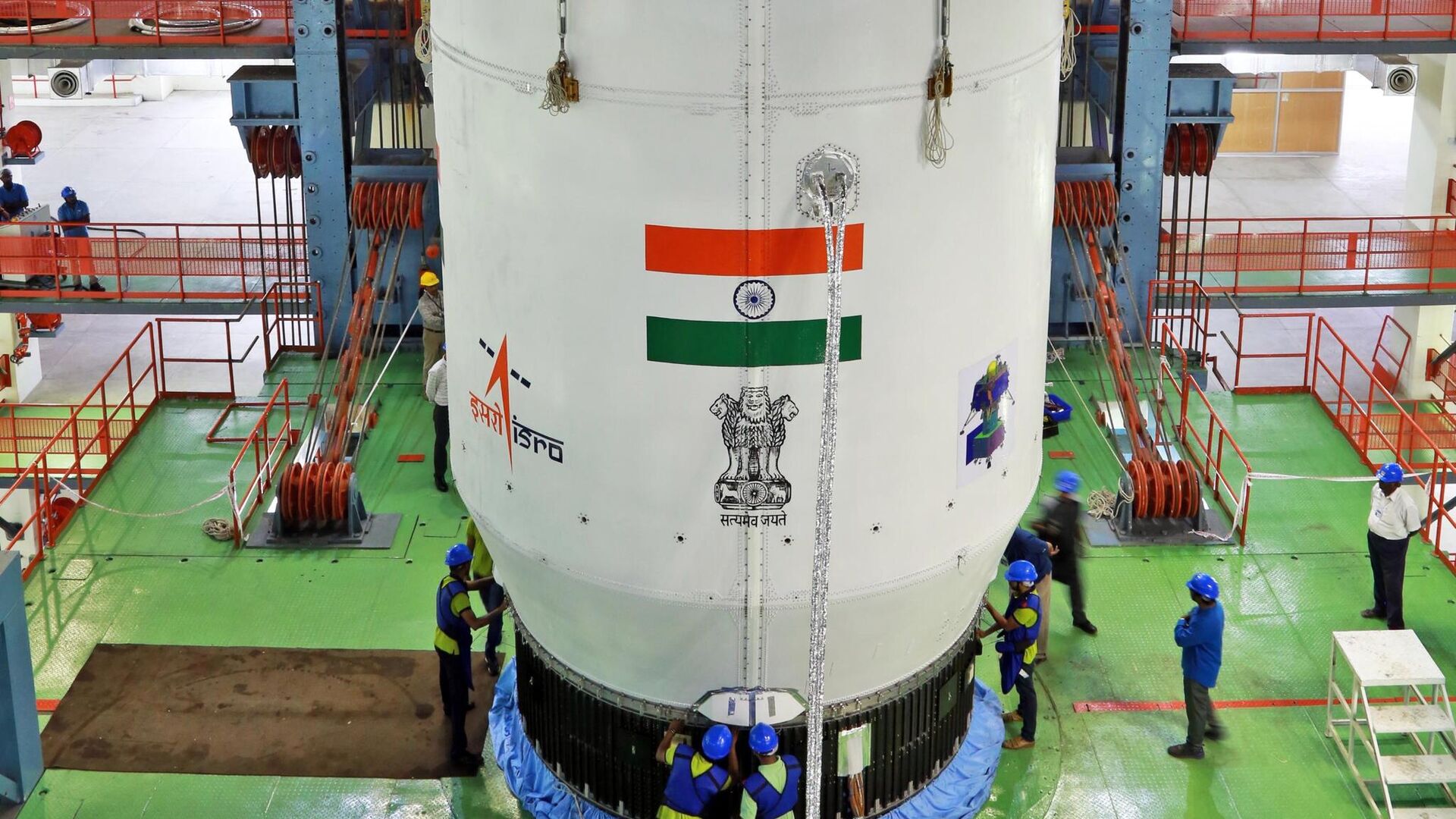https://sputniknews.in/20230705/chandrayaan-3-isro-integrates-lunar-spacecraft-with-launch-vehicle-2850361.html
Chandrayaan-3: ISRO Integrates Lunar Spacecraft With Launch Vehicle
Chandrayaan-3: ISRO Integrates Lunar Spacecraft With Launch Vehicle
Sputnik India
The Chandrayaan-3 mission, which is slated for the launch between July 13-19, will transport a state-of-the-art rover, an indigenous lander, and a propulsion module equipped with scientific payloads that intend to conduct experiments on the moon's surface.
2023-07-05T18:20+0530
2023-07-05T18:20+0530
2023-07-05T18:20+0530
science & tech
india
chandrayaan
space satellite
space industry
space rocket
indian space research organisation (isro)
moon
moon landing
https://cdn1.img.sputniknews.in/img/07e7/07/05/2851988_0:1584:2048:2736_1920x0_80_0_0_d40211753c3fa5e3ddc06a94f29ed67d.jpg
The Indian Space Research Organisation (ISRO) has shared a glimpse of the preparation ahead of Chandrayaan-3's launch. The Chandrayaan-3 is India's largest rocket Geosynchronous Launch Vehicle Mark 3 (GS-LVM3) stationed at Satish Dhawan Space Centre in Sriharikota, Andhra Pradesh state.A video tweeted by ISRO showcased the nose cone (payload fairing) of the rocket, carrying the Chandrayaan-3 lunar spacecraft placed on the launch vehicle.Previously, Chandrayaan-2's rover crash-landed on the Moon's surface due to some technical glitchs.However, the orbiter managed to float above the Moon and helped achieve path-breaking new discoveries like detecting the presence of water molecules on the moon.
https://sputniknews.in/20230530/indian-moon-mission-chandrayaan-3-to-be-launched-in-july-2023-isro-chief-2232842.html
india
moon
Sputnik India
feedback.hindi@sputniknews.com
+74956456601
MIA „Rossiya Segodnya“
2023
Sangeeta Yadav
https://cdn1.img.sputniknews.in/img/07e6/0c/0f/110602_0:0:641:640_100x100_80_0_0_c298016a79eb02ef8caa9d1f688c12a5.jpg
Sangeeta Yadav
https://cdn1.img.sputniknews.in/img/07e6/0c/0f/110602_0:0:641:640_100x100_80_0_0_c298016a79eb02ef8caa9d1f688c12a5.jpg
News
en_IN
Sputnik India
feedback.hindi@sputniknews.com
+74956456601
MIA „Rossiya Segodnya“
Sputnik India
feedback.hindi@sputniknews.com
+74956456601
MIA „Rossiya Segodnya“
Sangeeta Yadav
https://cdn1.img.sputniknews.in/img/07e6/0c/0f/110602_0:0:641:640_100x100_80_0_0_c298016a79eb02ef8caa9d1f688c12a5.jpg
chandrayaan 3, space exhibition, indian lunar mission, south pole of the moon, lvm-3, satish dhawan space centre, sriharikota, u r rao satellite centre, geosynchronous launch vehicle mark 3 (gs-lvm3), indian space research organisation, isro chairman s somanath, navigation satellite, nsv-01, safe landing and roving on the moon, scientific payloads, carry out experiments on the lunar surface,
chandrayaan 3, space exhibition, indian lunar mission, south pole of the moon, lvm-3, satish dhawan space centre, sriharikota, u r rao satellite centre, geosynchronous launch vehicle mark 3 (gs-lvm3), indian space research organisation, isro chairman s somanath, navigation satellite, nsv-01, safe landing and roving on the moon, scientific payloads, carry out experiments on the lunar surface,
Chandrayaan-3: ISRO Integrates Lunar Spacecraft With Launch Vehicle
The Chandrayaan-3 mission, slated to be launched between July 13-19, will transport a state-of-the-art rover, an indigenous lander, and a propulsion module equipped with scientific payloads that intend to conduct experiments on the Moon's surface.
The
Indian Space Research Organisation (ISRO) has shared a glimpse of the preparation ahead of
Chandrayaan-3's launch. The Chandrayaan-3 is India's largest rocket
Geosynchronous Launch Vehicle Mark 3 (GS-LVM3) stationed at Satish Dhawan Space Centre in Sriharikota, Andhra Pradesh state.
A video tweeted by
ISRO showcased the nose cone (payload fairing) of the rocket, carrying the Chandrayaan-3
lunar spacecraft placed on the launch vehicle.
Previously, Chandrayaan-2's rover crash-landed on the Moon's surface due to some technical glitchs.
However, the orbiter managed to float above the Moon and helped achieve path-breaking new discoveries like detecting the presence of water molecules on the moon.



